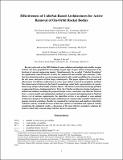Effectiveness of CubeSat-Based Architectures for Active Removal of On-Orbit Rocket Bodies
Author(s)
Clark, Christopher P.; Tan, Dun Y.; Arnal Luna, Patricia; Hastings, Daniel E.; Masterson, Rebecca A.; Ricard, Michael J.; ... Show more Show less
DownloadAccepted version (503.8Kb)
Open Access Policy
Open Access Policy
Creative Commons Attribution-Noncommercial-Share Alike
Terms of use
Metadata
Show full item recordAbstract
Recent events such as the 2009 Iridium-Cosmos collision and multiple anti-satellite weapon (ASAT) tests have propelled the increasingly urgent topic of space debris management to the forefront of current engineering inquiry. Simultaneously, the so-called “CubeSat Revolution” has significantly reduced barriers to entry for commercial and scientific space missions. Cube-Sats have demonstrated an ever-increasing potential to offer useful capabilities for a fraction of the size, mass, and power of their larger counterparts. This paper explores the relevance and effectiveness of CubeSat architectures in active space debris removal by propulsive methods. The chosen target of interest is the Zenit-2 second-stage rocket body, representative of a particularly large and prevalent family of debris objects. The debris removal mission design problem is approached from a fundamental level. First, the CubeSat architecture design tradespace is defined and outlined, including the proposed design vector, constraints, and objective function. Next, a system model and optimization methods are presented and implemented in MATLAB. Given a set of mission requirements, the algorithm arrives at an optimal or near-optimal architecture design by iterating through combinations of commercially available CubeSat components stored in a database. Results are examined for various deorbiter CubeSat designs, and key tradeoffs between architecture options are identified and explored. Finally, considering the optimized results, a discussion of the most effective propulsive solutions for Zenit-2 rocket body removal using CubeSat clusters is presented.
Date issued
2020-11Department
Charles Stark Draper Laboratory; Massachusetts Institute of Technology. Department of Aeronautics and AstronauticsJournal
Accelerating Space Commerce, Exploration, and New Discovery Conference
Publisher
American Institute of Aeronautics and Astronautics
Citation
Clark, Christopher P. et al. "Effectiveness of CubeSat-Based Architectures for Active Removal of On-Orbit Rocket Bodies." Accelerating Space Commerce, Exploration, and New Discovery Conference, November 2020, virtual event, American Institute of Aeronautics and Astronautics, November 2020. © 2020 The Charles Stark Draper Laboratory, Inc
Version: Author's final manuscript
ISBN
9781624106088